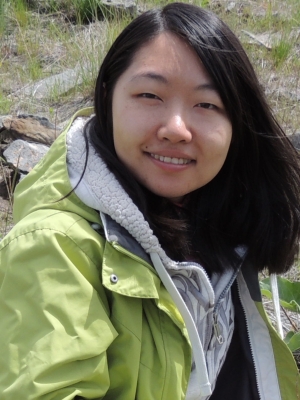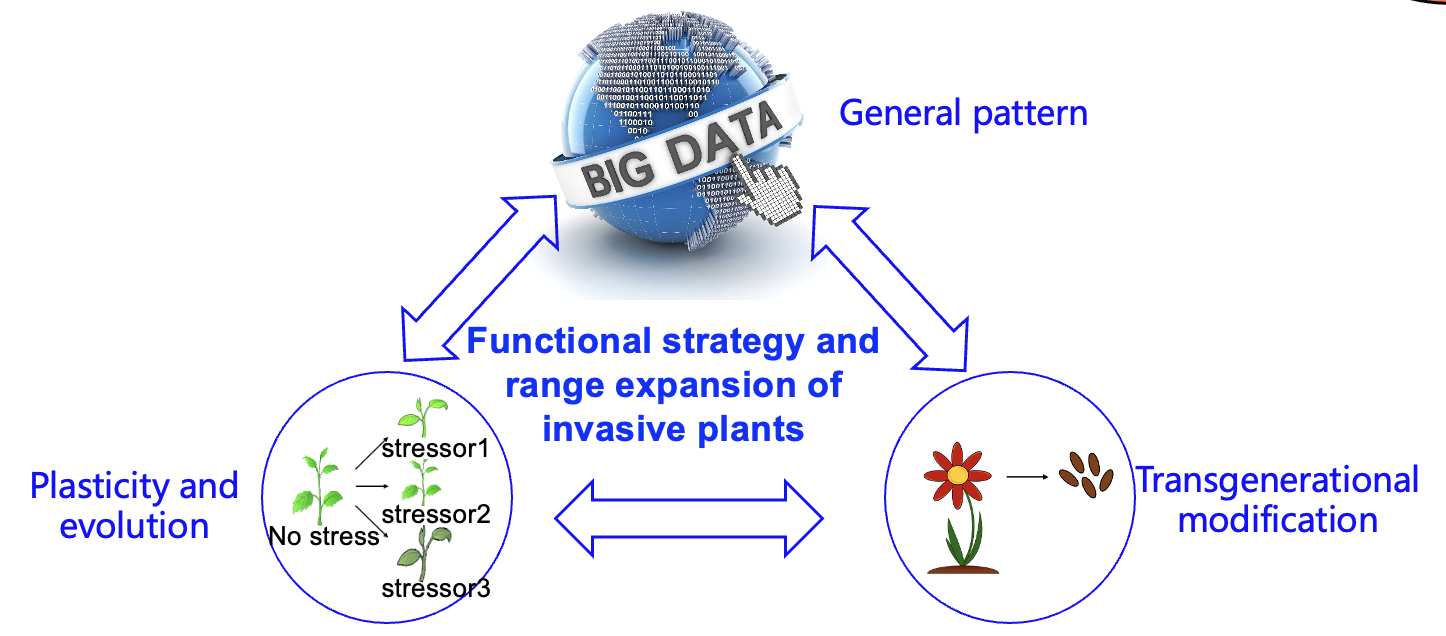
LIAO Huixuan
Associate Professor / Master's supervisor
Direction:Biodiversity
Research Area:My research focuses on unraveling the mechanisms that enable invasive plants to rapidly expand their geographical ranges. I employ a comprehensive, multi-scale approach, integrating macro, meso, and micro perspectives to examine the intricate interactions between invasive plants and their surrounding ecosystems. Specifically, I investigate how functional traits of invasive species mediate plant-plant, plant-microbe, and plant-insect interactions, which ultimately facilitate successful invasions. By elucidating these complex relationships, my work aims to provide critical insights for predicting the hotspots for plant invasions and developing effective strategies to manage and mitigate the impacts of invasive species.
Tel: 020-84112424
Email: liaohuix5@mail.sysu.edu.cn
Address: 广州市海珠区新港西路135号生物楼430室
Basic information
E-MAIL: liaohuix5@mail.sysu.edu.cn
MAILLING ADDRESS: No. 66 Gongchang Road, Guangming District, Shenzhen, Guangdong Province, China
PERSONAL WEBSITE: https://www.researchgate.net/profile/Huixuan_Liao
CURRICULUM VITEA

As an Associate Professor at the School of Ecology, Sun Yat-sen University, my research is dedicated to understanding the ecological dynamics that enable invasive plants to expand their distribution ranges. My work explores the complex interactions between invasive plants and their environment, focusing on plant-plant, plant-microbe, and plant-insect relationships through a multi-scale lens that integrates macro, meso, and micro approaches. This holistic methodology allows for a nuanced understanding of the functional traits that drive successful invasions. I earned my Bachelor and Ph.D. degrees from Sun Yat-sen University, and I further enriched my academic experience by visiting Prof. Ragan Callaway’s lab at the University of Montana as an exchange Ph.D. student from January 2013 to May 2014.
I am the primary investigator for eight research grants, including three national, four provincial, and one local research grants. I have published 36 research papers, including 14 first-author or corresponding-author papers that were published in top journals of ecology and conservation biology (e.g., Journal of Ecology, Ecology, Ecography, Conservation Biology). One Ecography paper and one Oikos paper have been selected as Editor’s Choice.
EDUCATION
Ph.D. Degree Sun Yat-sen University, 2015
Exchange Ph.D. Student University of Montana, 2013-2014
Bachelor’s Degree Sun Yat-sen University, 2011
WORK EXPERIENCE
School of Ecology, Sun Yat-sen University Associate Professor (2021-present)
School of Life Sciences, Sun Yat-sen University Associate Investigator (2016-2021)
HONORS AND AWARDS
National scholarship for doctoral student Ministry of Education of the PRC (2015)
RESEARCH GRANTS
- 2024-: Relationship between phenotypic plasticity and transposon abundance in invasive plants. National Natural Science Foundation General Programm 32371579. PI.
- 2021-: Relationship between regulatory capacity of arbuscular mycorrhizal fungi community and distribution ranges of plant species. National Natural Science Foundation General Programm 32071530. PI.
- 2018-2020: Mechanism for soil-microbe-driven succession of subtropical forests in South China. National Natural Science Foundation Young Scholar Programm 31700450. PI.
- 2024-: Spatial diversification of functional strategies of a noxious invasive weed, Mikania micrantha, and the potential regulatory mechanism by DNA methylation. Natural Science Foundation of Guangdong Province General Programm 2024A1515012462. PI.
- 2017-2020: The role of positive plant-microbe feedback in biodiversity maintenance of forest communities. Natural Science Foundation of Guangdong Province Young Scholar Programm 2017A030310386. PI.
PUBLICATIONS
First/Corrsponding Author:
- Liao H.*, Zhao H., Chen Z., Peng S. 2025. Drought response of trees: differences across mycorrhizal type at the global scale. Oikos (Early View)
- Luo W., Liao H.*, Callaway R., Pal R. 2025. Competition on a neutral playing field: invaders still win and size still matters… sometimes. Proceedings of the Royal Society B, 292(2043): 20250087.
- Gan Q., Liao H.*, Liu J., Peng S. 2024. Spatiotemporal interaction of risk-spreading strategies for a seed-dimorphic plant. Journal of Ecology, 112(7): 1613-1623.
- Gan Q., Liu J., Liao H.*, Peng S.* 2023. Dimorphism-dependent transgenerational effects facilitate divergence of drought tolerance in Synedrella nodiflora. Journal of Plant Ecology, 16(1): rtac042.
- Liao H.*, Pal R.W., Niinemets Ü., Bahn M., Cerabolini B., Peng S.* 2021. Different functional characteristics can explain different dimensions of plant invasion success. Journal of Ecology, 109(3): 1524-1536.
- Liao H.*, Li D., Zhou T., Huang B., Zhang H., Chen B., Peng S.* 2021. The role of functional strategies in global plant distribution. Ecography, 44(4): 493-503.
- Liao H., Wang H., Dong Q., Cheng F., Zhou T., Peng S.* 2019. Estimating non-native plant richness with a species-accumulation model along roads. Conservation Biology, 34(2): 472-481.
- Liu M., Liao H.*, Peng S.* 2019. Salt‐tolerant native plants have greater responses to other environments when compared to salt‐tolerant invasive plants. Ecology and Evolution, 9(13):7808-7818.
- Liao H.*, Huang F., Li D., Kang L., Chen B., Zhou T., Peng S.* 2018. Soil microbes regulate forest succession in a subtropical ecosystem in China: evidence from a mesocosm experiment. Plant and Soil, 430:277-289.
- Zhou T.#, Jia X.#, Liao H.#, Peng S., Peng S.* 2016. Effects of elevated mean and extremely high temperatures on the physio-ecological characteristics of geographically distinctive populations of Cunninghamia lanceolata. Scientific Reports, 6: 39187.
- Liao H., D’Antonio C. M., Chen B., Huang Q., Peng S.* 2016. How much do phenotypic plasticity and local genetic variation contribute to phenotypic divergences along environmental gradients in widespread invasive plants? A meta-analysis. Oikos, 125: 905-917.
- Liao H., Gurgel P. C. S., Pal R. W., Hooper D, Callaway R. M. 2016. Solidago gigantea plants from nonnative ranges compensate more in response to damage than plants from the native range. Ecology, 97(9): 2355-2363.
- Liao H., Luo W., Pal R., Peng S.*, Callaway R.M.* 2016. Context-dependency and the effects of species diversity on ecosystem function. Biological Invasions, 18: 3063-3079.
- Liao H., Luo W., Peng S.*, Callaway R. M*. 2015. Plant diversity, soil biota and resistance to exotic invasion. Diversity and Distributions, 21: 826-835.
Co-authored:
- Luo W.,Liao H.,Pal R.W., Callaway R.M. 2025. Escape from harmful soil biota at high elevations: Plant–soil feedbacks along stress gradients.Ecology, 106(5): e70112.
- HuM.,ChenH.Y.H.,ChangS.X.,LeuzingerS., DukesJ.S., LangleyJ.A., BaderM.-F., Van SundertK.,LiaoH., MaZ.2025. Plant functional traits affect biomass responses to global change: A meta-analysis.Journal of Ecology, 113, 2046–2065.
- Yao N., Liu A., Wang X., Deng H., Fan S., Zhang H.,Liao H., Peng S., Chen B. 2024.Influence of arbuscular mycorrhizal fungi on root foraging and competitive ability depends on soil phosphorus distribution: evidence from two pairs of invasive and native plants.Applied Soil Ecology, 201: 105507.
- LiuJ., LiaoH., FanM., ZhouT., PengS.2023. Comparison of root morphology and rhizosphere microbial communities form moso-bamboo in different forest types. Ecology and Evolution,13: e10153.
- Huang L., Liao M.,Liao H., Liu Z., Cai H., Zhou W., Xu Z., Ouyang K., Yang W., Jian S. 2024.High phosphorus availability and low light intensity reduce the competitive ability of the invasive plantChromolaena odorata in tropical coral islands.Biological Invasions,26: 471-487.
- Han X., Yao N., Wang X., Deng H., Liao H., Fan S., Chen B. 2023. Short-term effects of asymmetric day and night warming on soil N2O, CO2 and CH4 emissions: A field experiment with an invasive and native plant. Applied Soil Ecology, 187: 104831.
- Huang F., Zhou G.,Liao H., Fan Z., Chen B.* 2022. Simulated nitrogen deposition induces shifts in growth and resource-use strategies during range expansion of an invasive plant.Biological Invasions,24: 621-633.
- Debnam, S.,Liao, H., Callaway, R.M.* 2021. Indirect facilitation mediated by pollinators in intermountain prairie. Community Ecology, 22: 309-317.
- Chen E.,Liao H., Chen B., Peng S.* 2020. Arbuscular mycorrhizal fungi are a double-edged sword in plant invasion controlled by phosphorus concentration. New Phytologist, 226(2): 295-300.
- Pal R.*, Maron J., Nagy D.U., Waller L.P., Tosto A., Liao H., Callaway R.M. 2020. What happens in Europe stays in Europe: apparent evolution by an invader does not help at home. Ecology, 101(8): e03072.
- Chen W.B., Chen B.M.*,Liao H.X., Su J.Q., Peng S.L. 2019. Leaf leachates have the potential to influence soil nitrification via changes in soil ammonia-oxidizing archaea and bacteria populations. European Journal of Soil Science, 71(1): 119-131.
- Fan Z.X., Chen B.M.,Liao H.X., Zhou G.H., Peng S.L.* 2019. The effect of allometric partitioning on herbivory tolerance in four species in South China. Ecology and Evolution, 9(20): 11647-11656.
- Peng S., Feng Z.,Liao H., Huang B., Peng S.*, Zhou T.* 2019. Spatial-temporal pattern of, and driving forces for, urban heat island in China. Ecological Indicator, 96: 127-132.
- Chen B.M.*, Su J.Q.,Liao H.X., Peng S.L.* 2018. A greater foraging scale, not a higher foraging precision, may facilitate invasion by exotic plants in nutrient heterogeneous conditions. Annals of Botany, 121: 561-569.
- Peng S.,Liao H., Zhou T., Peng S.* 2017. Effects of UVB radiation on freshwater biota: a meta-analysis. Global Ecology and Biogeography, 26(4):500-510.
- Chen B.M., Gao Y.,Liao H. X., Peng S. L.* 2017. Differential responses of invasive and native plants to warming with simulated changes in diurnal temperature ranges. AoB Plants, 2017, 9(4):plx028.
- Chen B.M., Li S.,Liao H.X., Peng S.L.* 2017. Do forest soil microbes have the potential to resist plant invasion? A Case study in Dinghushan Biosphere Reserve (South China). Acta Oecologica, 81:1-9.
- Chen B.M.*,Liao H.X., Chen W.B., Wei H.J., Peng S.L.* 2017. Role of allelopathy in plant invasion and control of invasive plants. Allelopathy Journal, 41(2):155-166.
- Liu J.G.,Liao H.X., Chen B.M., Peng S.L.* 2017. Do the phenolic acids in forest soil resist the exotic plant invasion?. Allelopathy Journal, 41(2):167-175.
- Huang F., Peng S.*, Chen B.,Liao H., Huang Q., Lin Z., Liu G. 2015. Rapid evolution of dispersal-related traits during range expansion of an invasive vine Mikania micrantha. Oikos, 124(8):1023-1030.
- Chen F., Peng S.*, Chen B., Ni G.,Liao H.2013. Allelopathic potential and volatile compounds of Rosmarinus officinalis L. against weeds. Allelopathy Journal, 32(1):57-66.
- Liu G., Huang Q., Lin Z., Huang F.,Liao H., Peng S.* 2012. High tolerance to salinity and herbivory stresses may explain the expansion of Ipomoea cairica to salt marshes. Plos One, 7(11): e48829.
PUBLISHED BOOKS
- Peng S., Zhou T., Liao H., Zhang H., Chen E., Chen B. 2020. Beijing: Science Press.
- Zhou T., Liao H. 2018. Construction and Application of a Quantitative Assessment Framework for Natural Resources and Environment Quality. Beijing: Science Press.


